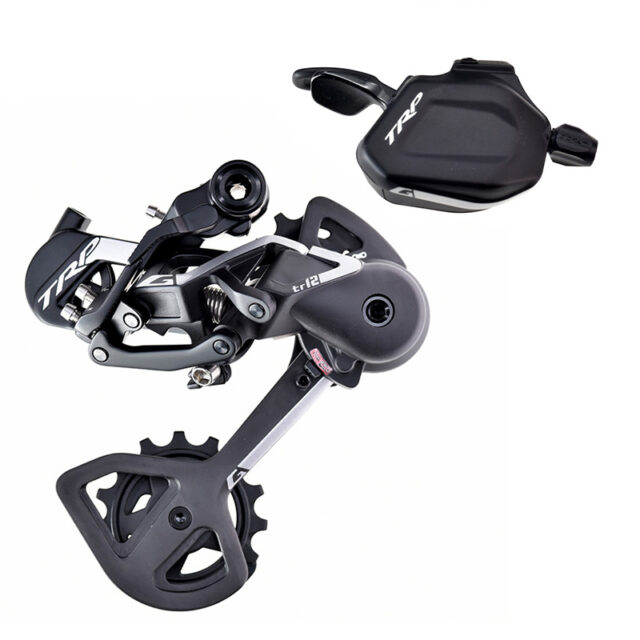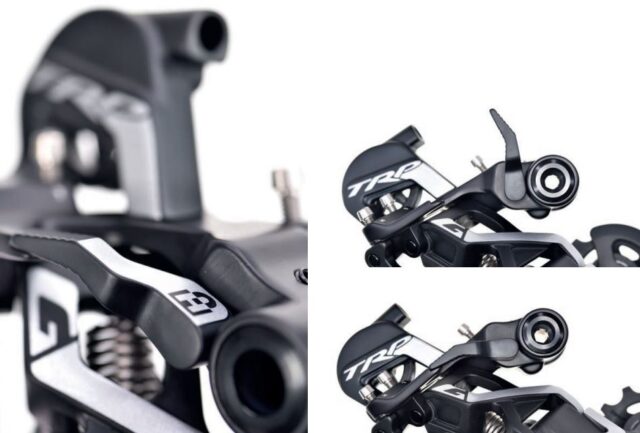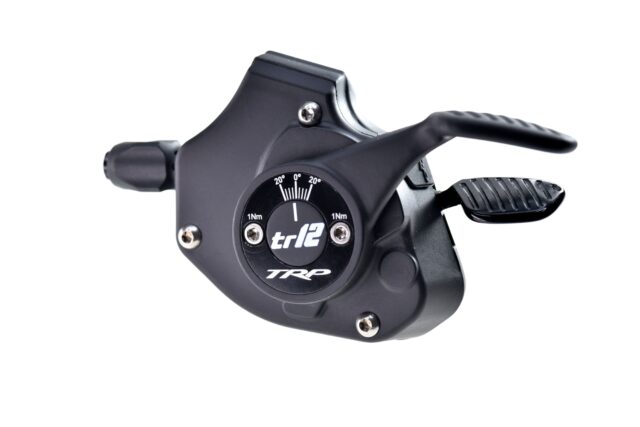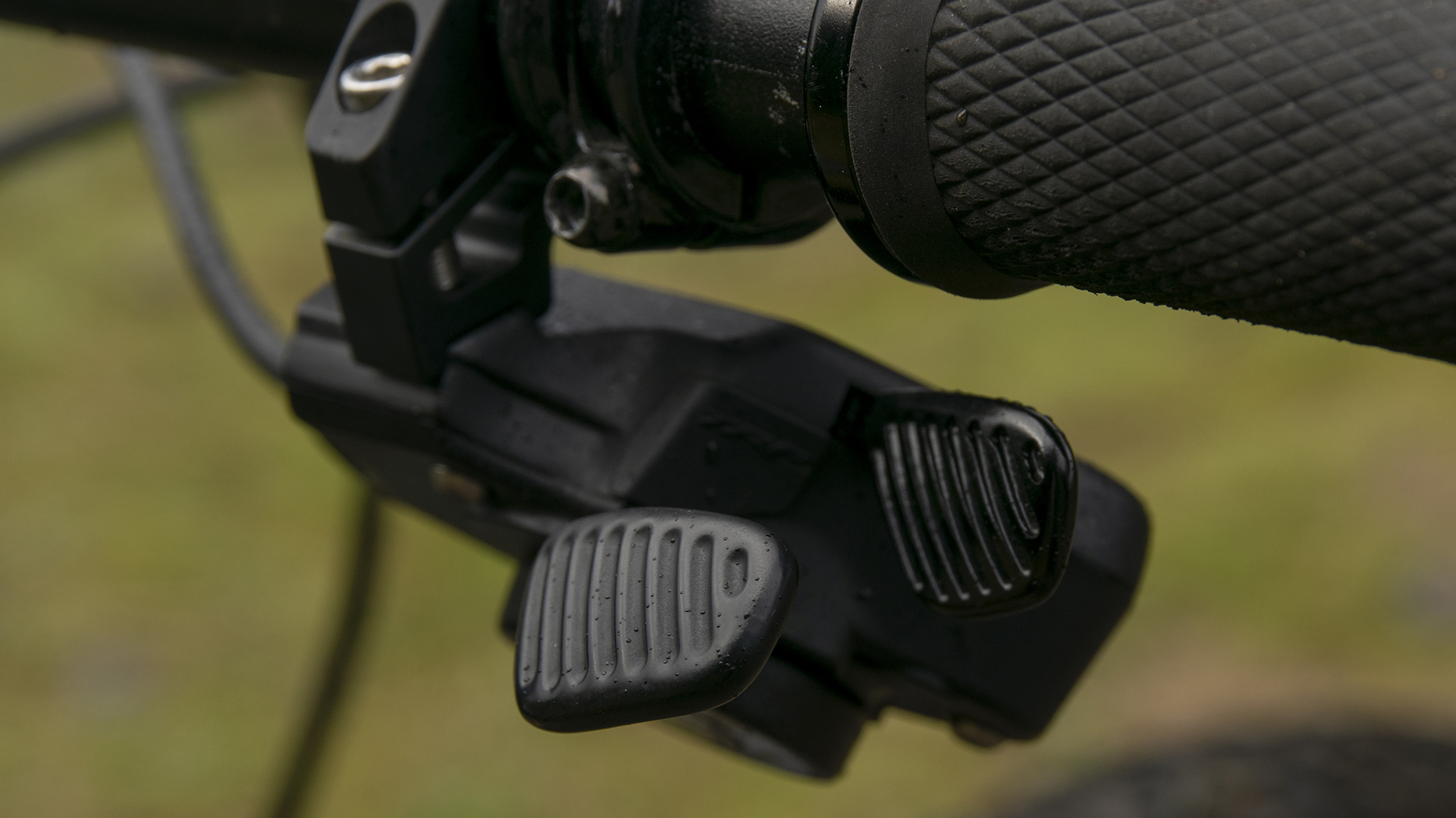TRP TR12 Shifter and Derailleur
Blister’s Measured Weight:
- Shifter: 114 g
- Derailleur: 290 g
MSRP: $330 for shifter + derailleur package
Bolted to: Guerrilla Gravity Gnarvana and Privateer 161
Reviewer: 6’, 170 lbs / 183 cm, 77.1 kg
Test Locations: Washington
Test Duration: ~6 months

Intro
SRAM and Shimano have long dominated the mountain bike drivetrain landscape, but a few new contenders are edging onto their turf. TRP made their first foray into the market with their DH7 shifter and derailleur in 2019, and have followed it up with the TR12 version, for use with wide-range, 12-speed cassettes. We’ve been testing the TR12 combo, and have found it to have some interesting features. But does that add up to a viable competitor to the SRAM and Shimano’s duopoly?

The Design
Developing a new drivetrain is a daunting task. Shifters and derailleurs are complex parts, and the major players have decades of experience in refining their designs. The degree to which SRAM and Shimano have dominated the market speaks to the difficulty of producing a viable competitor, and we’re excited to see some new contenders trying their hand.
To keep things simple, TRP didn’t make a complete drivetrain, and instead focused on the shifter and derailleur. The TR12 package is meant to work with a 12-speed cassette and chain from another manufacturer, with up to a 50-tooth large cog. Unfortunately, that means that the latest 51-tooth Shimano and 52-tooth SRAM cassettes aren’t compatible. TRP lists 50-tooth SRAM Eagle cassettes as offering the “best” compatibility, and the 10-45-tooth variant of Shimano’s 12-speed offerings are categorized as being “better” matches. Sunrace and e*thirteen cassettes are deemed “good.”
The TR12 shifter and derailleur are quite similar to the DH7 versions that preceded them, reconfigured for wider-range cassettes, and bumped up from 7 speeds to 12. The DH7 was TRP’s first drivetrain to come to market, and was developed with the help of Aaron Gwin and his mechanic, John Hall. That a similar 12-speed system followed is no great surprise, and both feature several novel features that set them apart from their competitors.
The Derailleur
At first blush, there’s not too much out of the ordinary with the TR12 derailleur. Its overall form is standard: it’s cable-actuated, with cable pull moving the derailleur into lower gears (i.e., larger cogs) and a return spring to do the reverse. A cage with a pair of pulleys manages chain tension, and a clutch mechanism is employed to keep the cage in check and the chain taut.

Like Shimano’s offerings, the TR12 derailleur’s clutch can be engaged and disengaged with the flip of a switch, and its tension can be adjusted to compensate for wear, or just set it to your preference. In the case of the TR12 derailleur, the clutch adjustment is performed by turning a pair of screws located on the back side of the derailleur cage, near the upper pulley. Removing the rear wheel makes access much easier, but it can be done with the wheel on, with the help of a long wrench. The adjustment is quite sensitive — the two screws are meant to be adjusted in concert, and just ⅛ of a turn of both makes a substantial difference.
The TR12’s clutch feels fairly normal when extending the cage by hand, but ratchets noticeably on the return stroke. I haven’t felt that this makes a particular difference one way or the other on the bike, apart from a very, very tiny bit of noise. It’s not enough to be audible most of the time on the bike, but very sharp-eared riders might pick up a hint of it on occasion.

Perhaps the most interesting feature of the TR12 derailleur is the “Hall Lock” on the B-pivot (i.e., the rotation of the derailleur about the mounting bolt). Named for Aaron Gwin’s mechanic, John Hall, who came up with the concept, the Hall Lock is essentially a cam lever that locks the rotation of the B-pivot. The idea is to reduce movement to improve chain retention and limit noise from chain slap. On most derailleurs, the B-pivot exists to allow the derailleur to rotate backward to facilitate rear-wheel removal, and in the event of an impact, to mitigate damage to the derailleur. The Hall Lock isn’t entirely rigid, and can still give way, should the derailleur take a hard enough impact, but is meant to keep it from moving under normal operation. Tension of the Hall Lock is adjustable via a single screw on the back of B-knuckle, and the Hall Lock can be disengaged to remove the rear wheel or reset the derailleur position, should it suffer a major impact.

TRP has a couple more tricks up their sleeve when it comes to the setup of the TR12 derailleur. First is an indicator to set the chain length: simply route the chain through the derailleur and over the chainring and cassette, in the smallest cog, and find the length of chain that lines up the two little chain icons on the knuckle and cage of the derailleur. I initially installed the TR12 on the Guerrilla Gravity Gnarvana, which I had previously set up with a full SRAM GX Eagle drivetrain, and the chain length carried over nicely.

There’s also an indicator for the B-tension screw, this time on the back of the derailleur cage. For that one, shift into the lowest gear, and then tweak the B-tension such that the mark on the back of the derailleur cage lines up with the top of the teeth on the largest cog on the cassette.
Both of the indicators worked well for my setup on both the Gnarvana and the Privateer 161. Shimano offers a similar indicator for B-tension on their 12-speed derailleurs, but I’ve found it to recommend slightly higher B-tension than would be ideal for optimal shifting performance; SRAM recently introduced a clip-on tool that works well, but isn’t integrated into the derailleur as neatly.

The Shifter
The TR12 shifter uses a conventional trigger shifter layout, with two thumb-actuated shift paddles in a similar layout to those offered by SRAM and Shimano. The upshift trigger only operates in a push manner, and releases one gear at a time; the downshift paddle can swing through up to four gears in one stroke.
The angle of the downshift paddle is adjustable by +/- 20° by loosening a pair of bolts on the bottom of the cover, repositioning the lever, and retightening the bolts. The position of the upshift trigger is fixed, but its ergonomics are interesting as well. Rather than operating as a pivoting lever, which rotates away from the thumb as it is actuated, the TR12’s lever moves linearly and diagonally, to better follow the arc of the thumb as it pushes forward.

Both paddles have significant ridges for grip, and while the ergonomics aren’t wildly different from the competition, the TR12 shifter does feel subtly different.
[The shifter ergonomics of Shimano’s 12-speed offerings are similar enough across the board that I’m going to refer to them as a monolith for this section; the only major difference is that the XT and XTR level shifters can upshift two gears with one stroke, while the lower-level versions are limited to one. SRAM’s mechanical (i.e. not the AXS electronic) offerings are mostly similar to each other as well, with an adjustable downshift paddle on the X01 and XX1 shifters as the major point of differentiation.]
The TR12 upshift trigger sits slightly closer to the rider than it does on SRAM or Shimano’s systems; whether this is a good thing or bad will be a matter of personal preference. For my (big — I wear an XL or XXL glove) hands, I slightly prefer the deeper-set positioning of SRAM’s offerings, in particular, but it’s a minor difference and it only takes me a few minutes to readjust when switching between bikes / shifters.
The change that I really notice, and appreciate, with the TR12 shifter’s upshift trigger is the linear motion, which truly does a better job of following the motion of the thumb than pivoting triggers. Before I’d spent time on it, I wondered if the linear actuation would really be an improvement, or a bit of a gimmick. And while it’s not a huge difference, the motion of the TR12 trigger does feel more secure when it comes to avoiding a slipped thumb and mixed shift, and I’ve genuinely come to appreciate it.

After a short time with the TR12 shifter, I adjusted the downshift paddle inboard slightly (i.e., away from the rider) to make it a touch easier to reach. I’m happy with the position that puts the downshift paddle in, but I do wish that the face of the paddle was angled inwards (i.e., towards the center of the bike) slightly more. As it is, the shape feels like it’s sloping away from my thumb slightly, and feels like it doesn’t cup my thumb as securely as I might like. I don’t recall ever badly slipping my thumb off to miss a shift, so it’s a purely tactile gripe, rather than a truly functional one, but it does feel a bit different than Shimano or SRAM’s shifters in that regard.
Weights, Price, and Comparisons
At $330 MSRP for the shifter and derailleur, the TR12 system is clearly aimed at the high-end portion of the market. We thought it would be useful to lay out the retail prices and weights for a few of its competitors, for reference.
TRP TR12:
- Derailleur: 290 g
- Shifter: 114 g
- Total: 404 g, $330
Shimano XT M8100:
- Derailleur: 281 g, $119
- Shifter (stated weight): 117 g, $63
- Total: 398 g, $182
Shimano XTR M9100:
- Derailleur: 244 g, $260
- Shifter: 117 g, $130
- Total: 361 g, $390
SRAM GX Eagle:
- Derailleur: 296 g, $125
- Shifter: 133 g, $45
- Total: 429 g, $170
SRAM X01 Eagle:
- Derailleur: 290 g, $199
- Shifter: 136 g, $89
- Total: 426 g, $288
SRAM XX1 Eagle:
- Derailleur (stated weight): 264 g, $300
- Shifter (stated weight): 122 g, $167
- Total: 386 g, $467
The two main takeaways here should be that (1) shifters and derailleurs are a pretty terrible way to save weight in terms of grams per dollar and that (2) while the TRP TR12 package isn’t quite as expensive as SRAM or Shimano’s top-tier options, it’s definitely priced like a premium product. While the weight savings at the top end tend to be pretty minor, there are very real differences when it comes to shifting performance and feel, so does the TRP 12 system stack up favorably?
On The Trail
The first part of my testing was conducted on a Guerrilla Gravity Gnarvana. I’d already spent some time on that bike with a full SRAM GX Eagle drivetrain, and swapped out the shifter and derailleur for the TR12, keeping the GX chain and 10-50t cassette. After a short time to adjust to the TR12’s slightly different shifter ergonomics (and tweak the downshift paddle position, as described above), the overall shifting performance was crisp, but not quite as smooth-feeling as higher-end options from SRAM (X01 & XX1) and, especially, Shimano (XTR). The TR12’s downshift paddle takes a little more force to actuate than average, and the feedback from the lever is just a touch more vague.
To be super clear, I’m drawing a distinction between shifting accuracy, and the feel at the shifter paddle. As long as I used a modicum of good technique (e.g., avoid downshifting four gears at a time while hard on the pedals), the TR12 shifter and derailleur hit their marks accurately. When downshifting, though, the bit of extra force required to push the paddle as compared to SRAM or Shimano’s high-end offerings mitigates the tactile feedback that you get through the shifter to know that a shift has or hasn’t neatly taken place.

The combination of the TRP TR12 shifter and derailleur with a SRAM GX Eagle cassette and chain can’t match the ability of Shimano’s Hyperglide+ 12-speed offerings — especially the top-tier XTR level — for its ability to wantonly mash through gears while pedalling hard, but I think a great deal of that magic is down to Shimano’s chain and cassette interface, and the TR12 system is at least no worse than the GX Eagle that it replaced in this regard.
On the second ride, I found myself needing to slightly tighten both the derailleur’s clutch and the Hall Lock. Both had loosened up a touch as they settled in, and were moving too freely, leading to a bit of extra noise and one dropped chain. I needed to tighten the clutch a second time after six months or so, but it’s a fairly easy job, and the clutch was solid and effective between tightenings.
A couple of months into my testing, I went to remove the rear wheel to change a tire, and noticed that the Hall Lock lever was sitting visibly askew. When I tried to open it, the shaft that the lever is attached to broke off. Now, it’s pretty clear that I’d hit the derailleur on something and bent the shaft, weakening it. There’s a big scuff on the side of the lever, and its position was visibly off-kilter. Derailleur strikes are a fact of mountain biking, and broken derailleurs will happen from time to time, so it’s probably not worth reading too much into it. The derailleur still works fine otherwise, and I can engage and disengage the Hall Lock by adjusting the tension screw on the back of the derailleur — it’s just no longer a tool-free operation.
Apart from that mishap — which, again, I really don’t fault the derailleur for — durability has been good. After quite a few miles and at least one major impact, the derailleur is still impressively solid and free of play, and after my initial tightening of the clutch and Hall Lock, I haven’t dropped a chain once. This is despite forgoing an upper chain guide for the purposes of testing chain retention. If not for that testing, I’d normally run one on these sorts of bikes. The overall package is quiet, too. It’s not a night and day difference, but the Hall Lock does make for an appreciable reduction in chain slap over rough terrain.
Bottom Line
So where does that leave us? The TR12 system is inarguably an impressive first effort at a wide-range drivetrain for TRP. There’s a reason that there are so few companies producing shifters and derailleurs for mountain bikes — SRAM and Shimano have been at this for a long time, and have such a wealth of experience that it’s a tall order for anyone else to catch up and break into that market.
TRP has come close, but ultimately I think it’s a little tough to justify the TR12 system at the price it commands. If TRP had made a slightly more basic version — say, drop the carbon fiber cage and knuckle from the derailleur, and found a way to keep broadly the same performance at a price that was a bit closer to SRAM GX or Shimano XT, I’d be telling a different story. TRP has made a very solid performer with their first crack at a wide-range drivetrain, and that’s no small feat. It’s just not quite as refined as the top-tier offerings that it’s priced against, making the TR12 a tough sell. But that said, I very much hope that TRP keep up their efforts in the drivetrain space. With a little more refinement, TR12 V2 could be truly excellent.

I’d strongly consider this if you know, it’s actually available to buy somewhere. Find a XT rear derailleur in stock these days is like seeing an albino Sasquatch.